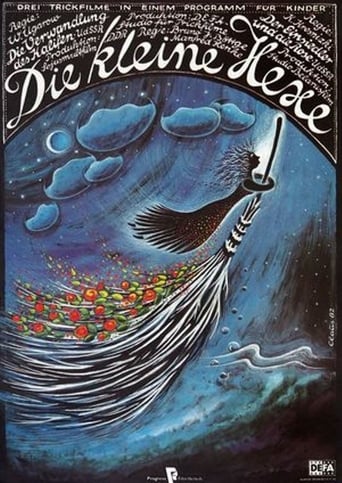DEFA-Studio für Trickfilme
The Magic Scissors 1957
Two hands prepare a paper cutting... They create a tailor made from black cardboard and let him go into a paper world. He comes alive and together with the scissors, which created him, he wanders around.
Die Geschichte vom Kalif Storch 1984
Caliph Harun al-Rashid was turned into a stork by a power-greedy rival. Only with the help of his wise vizier and a beautiful princess is he able to escape the spell. Based on a fairy tale by Wilhelm Hauff.
Einmart 1981
The very first images in the film set unprecedented standards in East German animated film: a Buñuelean eye that fills the entire screen, real-life sequences of fleeing animals and a sound collage running contrary to what is seen on the screen. This also extends to the protagonist of the film, a head on a foot without a body or arms who pads wearily through the depressing surroundings. Upon seeing various figures in the sky, he begins to copy their movements. To his surprise, he himself manages to grow wings and takes to the skies. But his attempt at flight ends in a sobering manner however, as it is revealed that flying creatures are just restricted in their range.
Vom mutigen Hans 1959
Metamorphoses I 1978
For the multimedia exhibition Tangenten I (Tangents I), Dammbeck and co-organizer, sculptor and painter Frieder Heinze had planned to collaborate on a film that would combine non-camera animation with 35mm footage of a train ride between the two Dresden districts of Radebeul and Pieschen. When the exhibition was banned in 1978, Heinze turned to other projects, but Dammbeck continued working on the film by himself. Metamorphoses I—the first experimental film ever to be shown publicly in East Germany—marks the filmic beginning of Dammbeck’s long-term art project the Herakles-Konzept (Hercules Concept).
Chile 1975
This short animation collage uncovers the financial backing of the Chilean Junta bosses by the US. Screened at the 1976 Oberhausen Int. Film Festival.
Lautaro 1978
The Mapuche tribe asks their Gods for help in difficult situations, including illness and drought. When the Spanish conquerers on their horses invade their country, the indigenous people think that they are aliens. The Spaniards capture and enslave many of the Mapuche tribe. Lautaro, a young captured native, realizes that these aliens are human beings without any divine power. He learns to use their weapons and organizes a resistance movement against the intruders.
Jorinde und Joringel 1958
Die sieben Raben 1970
The Flying Windmill 1982
Olli, the main character in the movie, got a very bad grade and is terribly annoyed. She runs away from home and, together with a dog and a horse, finds a (mad? nutty?) scientist in a windmill. They experience the strangest adventures in this windmill and find other interesting characters, a lot of excitement and peril. While you may well interpret something as the "socialist value system" into this movie, it is more meant to be a children's movie, showing the kids that there are more exciting things out there than the ones that your parents and teachers show you, and that you will only find out most of those things on your own, if you show enough curiosity.
The Little Witch 1983
The little witch is not interested in the basics of magic. She does not want to study at all! But everything changes when she meets the handsome Prince and falls in love with him. She helps the Prince with her magical powers, protecting him from dangerous obstacles and marriage to a woman he does not love.
Rache 1967
A Young Man Named Engels – A Portrait in Letters 1970
With the young Friedrich Engel’s letters and drawings from the years between 1838 and 1842, a unique cinematic portrait is created. The viewer thus gets to know the young Engels personally, learning about the significant moments of his development from a bourgeois-liberal upbringing to the theoretical partner of Karl Marx. Later be awarded the Gold Dove at the International Leipzig Documentary and Short Film Week.



















